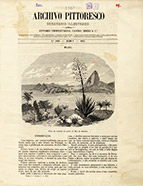

................................
References to the Madrépora Society, founded by Portuguese nationals living in Rio de Janeiro, became frequent in successive issues of AP. This association became a primary source of funding and support, helping to distribute the magazine to its members. Much like O Panorama , which grew during its affiliation with the Sociedade Propagadora de Conhecimentos Úteis (its sponsor until 1844), AP enjoyed its peak circulation and influence when the Madrépora Society took on responsibility for purchasing a significant portion of its print run and distributing it to educational institutions across Portugal, its overseas territories, and Brazil. This collaboration was particularly significant as Portugal was undergoing industrialisation, and associations like Madrépora, supporting the state’s educational objectives, reflected the era’s modernising forces. The ties with Brazil, evident from AP’s very first issue, continued to deepen through the support of influential figures associated with Madrépora. This intricate network connecting the royal government (which also distributed some copies of AP to schools), industrial and literary associations, the colonies, and Brazil offers key insights into the mid-19th century’s literate circles and their multifaceted roles. Even before Madrépora’s involvement, AP had already published articles showcasing the various branches of industry in Portugal and abroad. Under Madrépora's influence, however, coverage expanded systematically to include topics like nautical companies, railways, water supply, meteorology, and other scientific developments. This content was often paired with translated biographical pieces on figures like Lord Byron (by the English writer M. Macaulay), Rousseau, Spinoza, and Adam Smith, as well as numerous historical documents. During these years, the number of illustrations in AP also increased, reaching 140 prints by 1862. With the death of António Emílio Machado Reis, one of Madrépora’s founding members, the magazine's growth prospects were abruptly halted. A note at the end of one of the 1868 editions announced the magazine's closure, citing the debts of the Rio de Janeiro-based company. This interplay of promoting contemporary advancements while simultaneously upholding the past as a model of national regeneration offers a revealing look at the historical perspectives that emerged in this period of prolific publishing and evolving conceptions of time.
This work is financed by national funds through FCT - Foundation for Science and Technology, I.P, in the scope of the projects UIDB/04311/2020 and UIDP/04311/2020.
